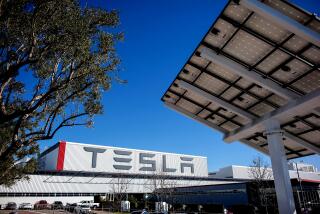California Poised to Gain From U.S. Refocus on Asia
- Share via
Westward Ho. Madeleine Albright, the incoming secretary of state, said last week that U.S. policy would begin to pay more attention to Asia. “We’re Eurocentric,”she said at her Senate confirmation hearings. “We need to look more to Asia.”
The European tilt of U.S. foreign policy has long worked to the disadvantage of California, which stands ready to supply everything from environmental technology to communications systems to fast-growing Asia.
Sen. Dianne Feinstein (D-Calif.) endorses Albright’s new focus. One-third of the vast economy of California is tied somehow to trade with Asia, Feinstein said.
That’s a lot of money: California’s annual output of goods and services amounts to $1 trillion now, a gross product greater than the GNP of all but six countries in the world.
The state’s economy, in fact, is far larger than those of all seven nations that Gov. Pete Wilson will visit on a trade mission that begins this weekend in Hong Kong.
Over the next three weeks, Wilson will meet with presidents and prime ministers in Indonesia, Singapore, Thailand, the Philippines, Taiwan and China. He visited Japan and South Korea on his last Asian trip in 1993.
As important, Wilson will meet in each country with local groups of California companies who are doing brisk business in Asia, thanks in some measure to strong foundations that were laid back home.
Three years ago, for example, the California Environmental Protection Agency set up a partnership with environmental companies to catalog available technical know-how and organize ways to sell it abroad.
The partnership helped some quite small companies realize how valuable and far-reaching their knowledge was.
Wilson will see one result of that effort on Jan. 22 when he attends a groundbreaking south of Manila of a $113-million project to convert garbage into electric power through a process developed by Alliance Bioremediation & Composting Corp. of San Diego.
How that project originated reveals a lot about how the world economy really works these days.
ABCC, a small private company that works with bacteria to convert waste materials, had participated five years ago in a trade mission to the Philippines looking for opportunities in water treatment.
But its people realized that a more immediate need was to get rid of a smoking trash heap, typical of Third World countries where urban settlements have mushroomed faster than sewage and garbage removal systems.
So ABCC went to work with its microbials and came up with a system to process garbage. Now, with a Philippine partner, ABCC will build a waste-to-energy plant near Manila and operate it for 25 years. “We sell the technology,” ABCC co-founder Dana Stewart says of her company’s role.
Selling technology is a growth business in Asia. Rapidly developing economies are not waiting for municipal authorities to arise and develop clean water systems, as happened in earlier ages in Japan, the U.S. and Western Europe. Instead, Asian countries are contracting with Western water companies, such as Lyonnaise des Eaux of France and Thames Water of Britain, to build systems for them.
U.S. firms get involved in providing the technology of modern water treatment and purification, explains Michael Rosenfeld, a vice president of Montgomery Watson, a Pasadena engineering firm that specializes in water treatment.
Montgomery Watson, a 50-year-old private firm that has 3,500 employees and employee owners around the world, gets 17% of its $435 million in annual revenue from Asia--the fastest-growing market.
The potential for environmental work is enormous, reckons the Asian Environmental Business Journal, a San Diego-based newsletter.
The developed economies of the U.S., Western Europe and Japan spend $368 billion a year on waste management and air and water purification.
But the far more populous developing countries of Asia spend only $16 billion. As their societies grow richer, so their environments can grow cleaner--with the help of technical know-how from California companies, universities and institutions.
Indeed, it is to spread the word that such expertise exists and is for sale that governors go on grueling three-week trade tours.
Wilson will also be mentioning Qualcomm, the San Diego-based wireless telephone technology company that is bidding against strong competition from European and other U.S. firms for huge projects in Taiwan and China.
Again, technology makes things easier. China, Taiwan and other Southeast Asian counties won’t be laying miles of underground telephone cable. Instead, they will go for wireless and satellite technology to more quickly give them modern telecommunications systems.
However, we should be aware that such healthy developments and growing opportunities won’t occur in a laboratory. Rather, commerce and economic development will proceed alongside political change and ferment, beginning with Hong Kong’s return to Chinese rule this July.
Human rights in China and political stability in Indonesia, among other issues in the region, will be important for U.S. politics. So greater knowledge of Asia is an acute need for Americans whose grasp of history is at best Eurocentric and skimpy.
For example, it would help put the present in context if Americans understood that in 1900, the countries of Asia held the same percentage of the world’s economic output that they hold today, writes Hong Kong-based U.S. economist Jim Rohwer in his book “Asia Rising.”
But in the interim, the nations of Asia lost hundreds of millions of people to war, famine and civil discord and saw their economies collapse. Then came the last 30 or so years of widespread economic development. Something historically profound is occurring.
And clearly, as Madeleine Albright suggests, it would be a good idea if Americans looked westward toward Asia and tried to understand what it is.
More to Read
Get the L.A. Times Politics newsletter
Deeply reported insights into legislation, politics and policy from Sacramento, Washington and beyond. In your inbox twice per week.
You may occasionally receive promotional content from the Los Angeles Times.










